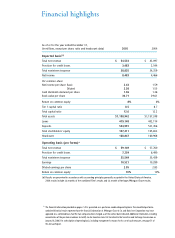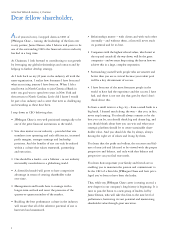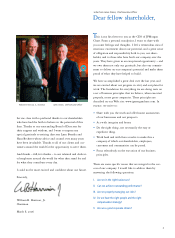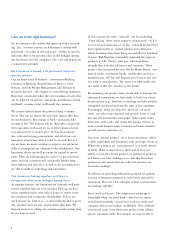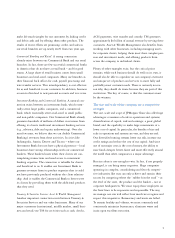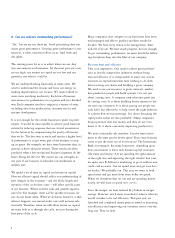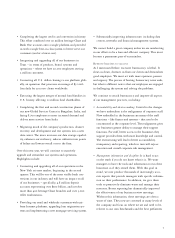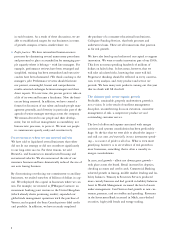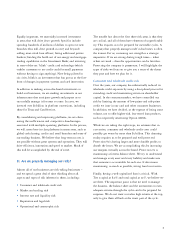JP Morgan Chase 2005 Annual Report Download - page 13
Download and view the complete annual report
Please find page 13 of the 2005 JP Morgan Chase annual report below. You can navigate through the pages in the report by either clicking on the pages listed below, or by using the keyword search tool below to find specific information within the annual report.
11
our exposure to potential operational loss. This approach
helps us determine whether we will be adequately capital-
ized in the event of such a loss. In addition to carefully
managing operational risk, we need to be prepared for
unforeseen disasters. Catastrophic risk can take a variety of
forms and significantly impair the performance and the
operations of the company. We have formal disaster recov-
ery and contingency plans in place. They worked well dur-
ing Hurricane Katrina and the bombings in London, but
we must continue to refine them as new risks appear.
Whatever the type of risk, the key point is that we try to
have a comprehensive approach to managing it. This
requires that the right people be in the right jobs and that
there be clear accountability in each business for managing
risk in addition to rigorous corporate oversight.
IV. Do we have the right people and the right
compensation strategy?
At the end of the day,it all comes down to people. We have
great people in this company. As I travel across the United
States and around the world, I have become increasingly
impressed with the talent and potential of our employees.
Rarely can a company assemble this level of creative fire-
power and professional competence.
To maximize the collective strength of our people, we will
need to work better as a team. Great teams are not great
because they have star athletes. Great teams are great
because the players have learned how to work together and
focus their collective energy and talent on winning. We are
in the early stages of building a great team.
The compensation cycle was difficult but productive this
year. Weare getting better at relating pay to performance.
But there is still room for improvement. Increasingly, we
also must orient ourselves to absolute performance against best-
in-class targets, not simply improvement in performance.
Wewant to be clear and truthful when we rate ourselves,
and fair as well as effective when evaluating performance.
Good performance goes beyond individual productivity to
include group, unit and company performance. Compensation
is not an entitlement; it should reflect an individual’s and a
team’s contribution to helping make this a great company.
We want to be one of the best-paying companies – but only
when we are one of the best-performing companies.
We also want our employees to feel and act like owners,
which is why stock is an important part of our compensa-
tion plans. Today more than , employees own, or
have an option to own, approximately %of shares in the
company. Executive Committee members are required to
retain %of their stock awards as long as they are with
the company. And in general, stock options are awarded on
alimited basis.
Wecontinually review our benefits programs to assure that
they are of value to employees and cost effective. For exam-
ple, the company has excellent medical benefits programs,
but we subsidize them more for lower-paid employees than
we do for higher-paid employees. (I hope that this instills a
sense of pride in our managers.)
In addition, we no longer match highly paid employees
in their (k); they have adequate pensions. Wedo not
offer perks to executives like club memberships, financial
planning and leased cars. Weare reducing excessive execu-
tive severance plans. But more importantly,we are paying
our employees more. Our thinking is simple – less compen-
sation through entitlements, more from performance.
We want to pay more and let our employees spend what
they earn as they see fit.
We need to constantly remind ourselves that the most
important thing we can do for employees is to build a
healthy,vibrant company that treats people with respect
and creates opportunity.Morale is not based upon perks;
morale builds from respect, growth, innovation and success;
from establishing a true meritocracy; from the stock per-
forming well; from customers liking to do business with us.
Agreat company will provide people with competitive
compensation, the opportunity to benefit as the company
grows and a rewarding career path.


